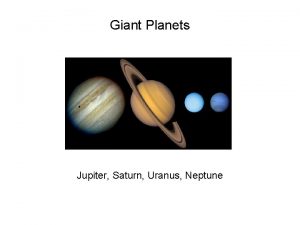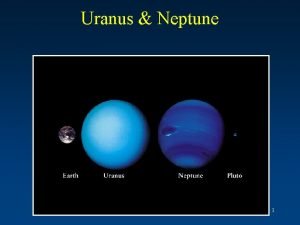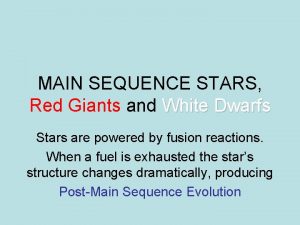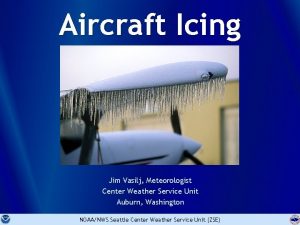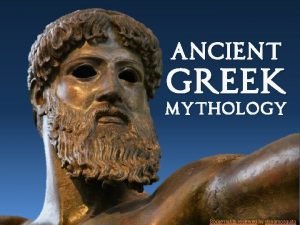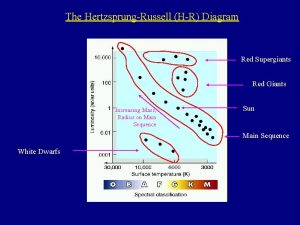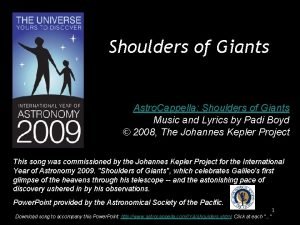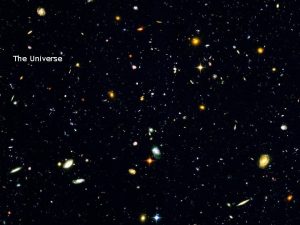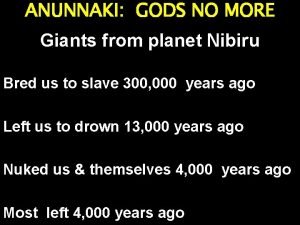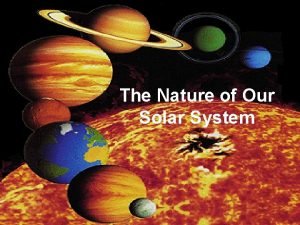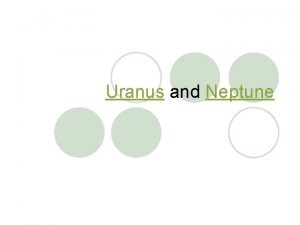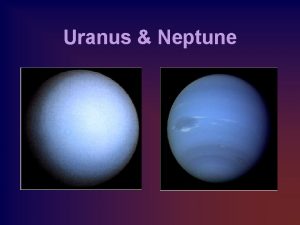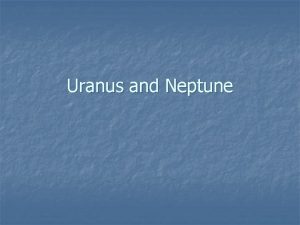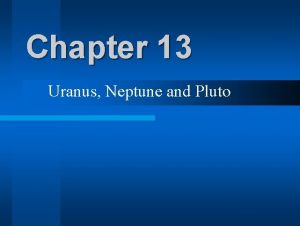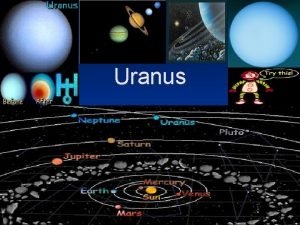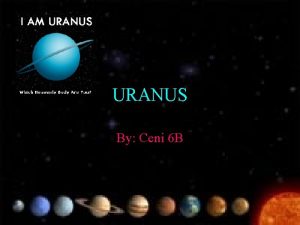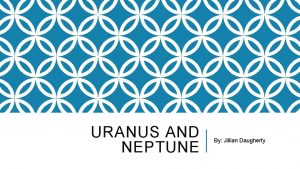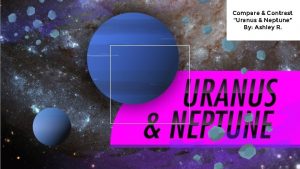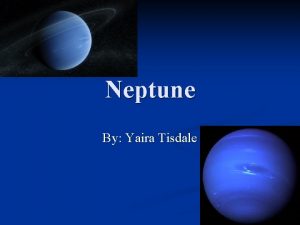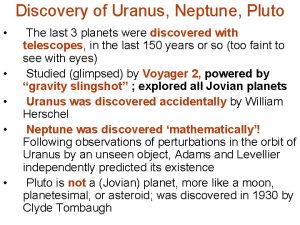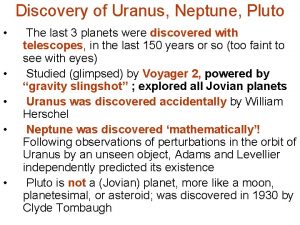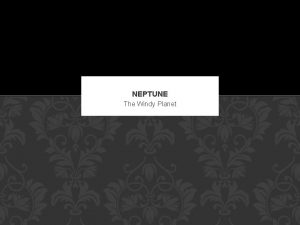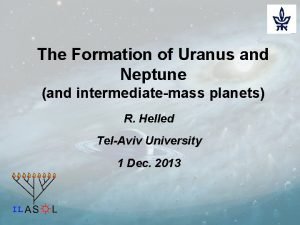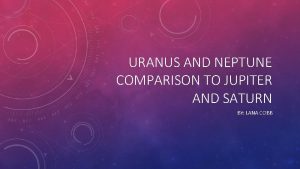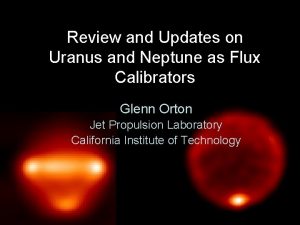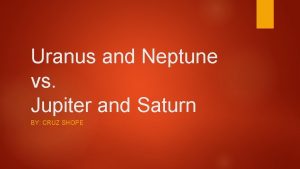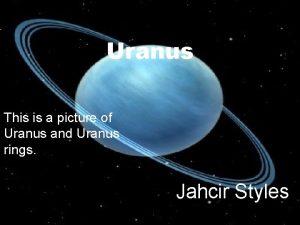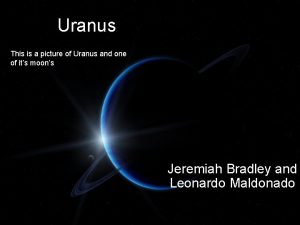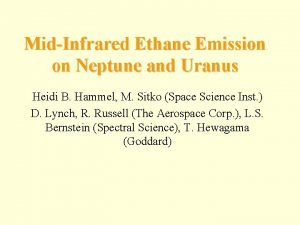The Ice Giants Uranus and Neptune The Discovery




























- Slides: 28

The Ice Giants Uranus and Neptune

The Discovery of Uranus Discovered in 1781 by Herschel; first planet to be discovered in more than 2000 years Little detail can be seen from Earth; arrows point to three of Uranus’s moons:

The Discovery of Neptune was discovered in 1846, after analysis of Uranus’s orbit indicated its presence Details of Neptune cannot be made out from Earth either; arrows again point to moons: Nereid Triton

Physical Properties of Uranus and Neptune are very similar:

Physical Properties of Uranus and Neptune Uranus Neptune Mass 14. 5 × Earth 17. 1 × Earth Radius 4. 0 × Earth 3. 9 × Earth Density 1300 kg/m 3 1600 kg/m 3

Uranus, Close Up

Physical Properties of Uranus and Neptune Peculiarity of Uranus: axis of rotation lies almost in the plane of its orbit. Seasonal variations are extreme.

The Atmospheres of Uranus and Neptune Outer atmospheres of Uranus and Neptune are similar to those of Jupiter and Saturn Uranus and Neptune are cold enough that ammonia freezes; methane dominates and gives the characteristic blue color

The Atmospheres of Uranus and Neptune Uranus is very cold; clouds only in lower, warmer layers. Few features are visible.

Neptune close up

The Atmospheres of Uranus and Neptune Band structure of Neptune is more visible, and Neptune has internal heat source of unknown origin:

The Atmospheres of Uranus and Neptune has storm systems similar to those on Jupiter, but fewer:

Magnetospheres and Internal Structure Uranus and Neptune both have substantial magnetic fields, but at a large angle to their rotation axes. The rectangle within each planet shows a bar magnet that would produce a similar field. Note that both Uranus’s and Neptune’s are significantly off center.

Magnetospheres and Internal Structure Magnetic fields of Uranus and Neptune must not be produced by dynamos, as the other planets’ fields are. Interior structure of Uranus and Neptune, compared to that of Jupiter and Saturn:

The Moon Systems of Uranus and Neptune

Table 13 -1 The Major Moons of Uranus

The Moon System of Uranus has 27 moons, five of which are major: Miranda, Ariel, Umbriel, Titania, and Oberon Very similar to Saturn’s medium-sized moons, except that all are much less reflective. Umbriel is the darkest:

The Moon System of Uranus Miranda is the most unusual; origin of the cracks and grooves is unknown:

The Moon System of Neptune has 13 moons, but only two can be seen from Earth: Triton and Nereid Triton is in a retrograde orbit; Nereid’s is highly eccentric Triton’s surface has few craters, indicating an active surface

The Moon System of Neptune : Triton Nitrogen geysers have been observed on Triton, contributing to the surface features:

The Moon System of Neptune Also, there appear to be ice volcanoes:

Occultation of Starlight

The Rings of the Outermost Jovian Planets Uranus and Neptune have faint ring systems, recently detected. Uranus’s rings are narrow:

Figure 13 -17 Epsilon Ring

The Rings of the Outermost Jovian Planets Two shepherd moons keep the epsilon ring from diffusing:

The Rings of the Outermost Jovian Planets Neptune has five rings, three narrow and two wide:

Summary • Uranus, Neptune, and Pluto were all discovered in the last 350 years • Uranus and Neptune are similar: gaseous and cold • Uranus’s spin axis is almost in the plane of its orbit • Surface features are hard to discern on Uranus, but more obvious on Neptune • Uranus has no excess heat emission, but Neptune does

Summary • Uranus’s midsized moons are similar to those of Saturn • Neptune’s moon Triton has a retrograde orbit • Uranus and Neptune both have faint ring systems
 Uranus and neptune size comparison
Uranus and neptune size comparison Phase diagram methane
Phase diagram methane 9.34.t - lesson: uranus, neptune & pluto assessment
9.34.t - lesson: uranus, neptune & pluto assessment Semi detached
Semi detached Icing
Icing Clear ice vs rime ice
Clear ice vs rime ice Titanomach
Titanomach Hundred handed giants greek mythology
Hundred handed giants greek mythology Gaea greek god
Gaea greek god Tyche family tree
Tyche family tree Hr diagram supergiants
Hr diagram supergiants Geriatric giants
Geriatric giants Giants of geriatrics
Giants of geriatrics Geriatric giants mnemonic
Geriatric giants mnemonic Giants by lydia pender
Giants by lydia pender They might be giants math
They might be giants math Giant geriatric syndrome adalah
Giant geriatric syndrome adalah They might be giants periodic table
They might be giants periodic table Galileo: on the shoulders of giants
Galileo: on the shoulders of giants Hundred handed giants greek mythology
Hundred handed giants greek mythology Standing on the shoulders of giants
Standing on the shoulders of giants Neptune's atmosphere
Neptune's atmosphere Lokiloki torrent magnet
Lokiloki torrent magnet Geriatic giants
Geriatic giants The first four outer planets do not have solid
The first four outer planets do not have solid They might be giants cells
They might be giants cells Anunnaki din nibiru
Anunnaki din nibiru Uranus belt
Uranus belt Jorda diameter
Jorda diameter
